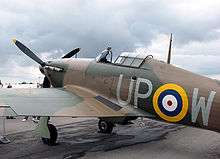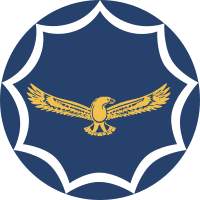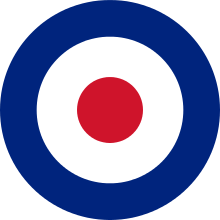Roundel
A roundel is a circular disc used as a symbol. The term is used in heraldry, but also commonly used to refer to a type of national insignia used on military aircraft, generally circular in shape and usually comprising concentric rings of different colours. Other symbols also often use round shapes.

Heraldry
In heraldry, a roundel is a circular charge. Roundels are among the oldest charges used in coats of arms, dating from at least the twelfth century. Roundels in British heraldry have different names depending on their tincture.[2] Thus, while a roundel may be blazoned by its tincture, e.g., a roundel vert (literally "a roundel green"), it is more often described by a single word, in this case pomme (literally "apple", from the French) or, from the same origins, pomeis—as in "Vert; on a cross Or five pomeis".[3]
One special example of a named roundel is the fountain, depicted as a roundel barry wavy argent and azure, that is, containing alternating horizontal wavy bands of blue and silver (or white).
Military aircraft

The French Air Service originated the use of roundels on military aircraft during the First World War.[1] The chosen design was the French national cockade, whose colours are the blue-white-red of the flag of France. Similar national cockades, with different ordering of colours, were designed and adopted as aircraft roundels by their allies, including the British Royal Flying Corps and the United States Army Air Service. After the First World War, many other air forces adopted roundel insignia, distinguished by different colours or numbers of concentric rings.
The term "roundel" is often used even for those military aircraft insignia that are not round, like the Iron Cross-Balkenkreuz symbol of the Luftwaffe or the red star of the Russian Air Force.
Flags
Among flags which display a roundel are the flag of Bangladesh and the flag of Japan.
Flags for British Overseas Territories are often a British Blue Ensign defaced with a white roundel displaying the arms or badge of the dependency. The same pattern is used for all the states of Australia except Victoria.
In popular culture
- The roundel, especially that used by the Royal Air Force, has been associated with pop art of the 1960s, appearing in paintings by Jasper Johns. It became part of the pop consciousness when British rock group The Who wore RAF roundels (and Union Flags) as part of their stage apparel at the start of their career. Subsequently it came to symbolise Mods and the Mod revival.
- Some of Paul Weller's material involves the use of a roundel in psychedelic colours.
- Ben Harper's album Fight For Your Mind uses roundels from several air forces as graphics in the liner notes.
- In the British television series Doctor Who, the circular decorations on the interior walls of the TARDIS control room are known as roundels.[4]
Examples
Military aircraft roundels




 Korean People's Army Air Force
Korean People's Army Air Force

Other roundels
Some corporations and organizations make use of roundels in their branding.


 S.S.C. Napoli, an Italian football club
S.S.C. Napoli, an Italian football club Winnipeg Jets, a Canadian NHL pro hockey team
Winnipeg Jets, a Canadian NHL pro hockey team Don Valley Parkway shield
Don Valley Parkway shield.svg.png) Logo of the Target Corporation
Logo of the Target Corporation Logo of Tide
Logo of Tide
See also
| Wikimedia Commons has media related to Roundels. |
| Wikimedia Commons has media related to Roundel. |
Notes
- "What is the origin of the RAF roundel?". Royal Air Force Museum. Archived from the original on 2009-06-02. Retrieved 2014-10-04.
In December 1914 the RFC followed the example of their French Allies and adopted red, white and blue circles...
- Fox-Davies, Arthur Charles (1909). A Complete Guide to Heraldry. Gutenberg.org. p. 151.
- Scottish Public Register vol. 32, p. 26
- Russell, Gary (2006). Doctor Who: The Inside Story. London: BBC Books. p. 86. ISBN 0-563-48649-X.
References
- Smith, Whitney (1975). Flags: Through the Ages and Around the World. McGraw Hill. pp. 24, 342. ISBN 0-07-059093-1.
- Donald, David, ed. (1986). The pocket guide to Military Aircraft and the World's Air Forces. Temple Press Aerospace. pp. 136–189. ISBN 0-600-55002-8.
